HORMONAL CONTROL OF EGG PRODUCTION AND UTERINE PREPARATION
- When levels of progesterone and oestrogen in the blood are low, the hypothalamus is triggered to secrete releasing hormones (GnRH).
- The releasing hormone stimulates the pituitary gland to produce FSH and LH which travel in the blood stream to the ovary.
-
The FSH stimulates follicles to grow but usually only one follicle with its oocyte mature each month.
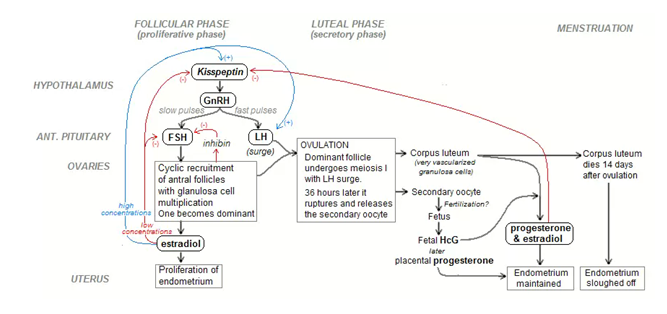
edu.uptymez.com
Fg: Interaction between hypothalamus pituitary gland and ovary representation of -ve and +ve feedback mechanisms.
- The follicle grows rapidly and secretes increasing amount of oestrogen.
- This hormone oestrogen causes the uterine lining to become thicker and more heavily supplied with blood.
- On about the 14th day of a 28 days cycle the pituitary gland secretes a large pulse of LH and additional FSH and these trigger the oocyte to complete the first meiotic division it began before birth.
- The developing follicle then rapture and releases the egg.
- Once the ovum has left the ovary and begins its trek down the oviduct, the follicular cells left behind in the ovary enlarge and form a new gland the corpus luteum (literally yellow body).
- The corpus luteum cells continue to secrete oestrogen but they begin now for the production of large quantities of progesterone as well.
- Together oestrogen and progesterone promote the continual build up of the uterine lining.
- The hormones as well inhibit the hypothalamus from making releasing factors and the pituitary from releasing FSH and LH.
- If the ovum does not encounter sperm on its down ward journey and it is therefore not fertilized diminishing levels of LH and FSH allows the corpus luteum to degenerate on day 24 of a cycle.
- Corpus luteum thus releases less and less oestrogen and progesterone.
-
As these hormones diminish; the endometrium begins to slough off and an approximately five days long period of menstrual flow starts making the beginning of the next cycle.
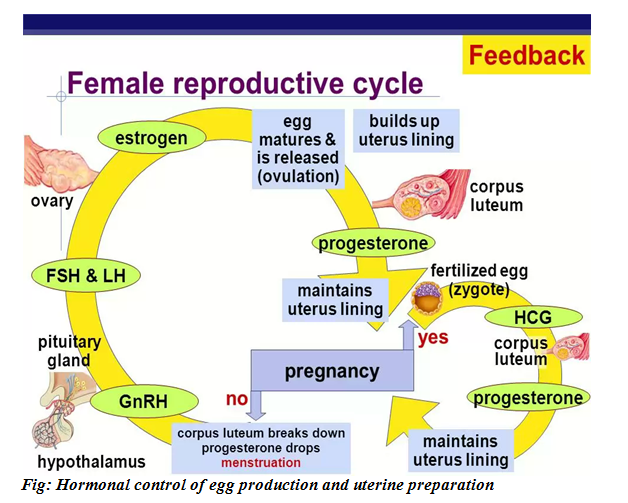
Fig: Hormonal control of egg production and uterine preparation
edu.uptymez.com
The control of the circuit of the hormonal cycle:
The control begins in the hypothalamus which produces gonadotrophin releasing hormone.
- The GnRH is received by receptors in the anterior pituitary gland which responds by releasing follicle stimulating hormone (FSH) and lutenizing hormone (LH) in a pulsatile manner.
-
At the beginning of the development, the granulosa cells express FSH receptors which stimulate growth of the follicle. Theca cells express receptor for LH which stimulates the growth of corpus luteum.
Theca cells also produce andogens which the granulosa cells convert into oestrogen.
edu.uptymez.com
Oestrogen acts back on the anterior pituitary gland to further FSH and LH surges, and also supports the growth of the endometrium.
-
At some point the dominate follicles begins to secrete inhibin, which acts back on anterior pituitary gland to stop producing FSH. Only the dominant follicle which is now FSH independent will continue to
grow.
- During further growth/development; the granulosa cells increase their FSH receptors and express LH while the theca cells increase LH receptors.
- This surge in hormone receptor results in ovulation.
-
After ovulation, if fertilization occurs; the corpus secretes progesterone that supports the further growth of endometrium. If, however fertilization does not occur, then the hormone level drops the
corpus luteum breaks down, no longer secrete progesterone, so that the endometrium sloughs off producing menstruation.
-
It is estimated that lens than 1% of all follicles reach the stage of the graafian follicle with 99% of follicles degenerating by apoptosis programmed cells death is an energy dependent process
accompanied by DNA degeneration.
-
The corpus luteum develops out of the raptured follicle immediately following ovulation corpus luteum is a vascularized version of the previous a vascular follicular epithelium with its intergration into the
circulatory system and the expression of the low density lipoprotein receptors, the follicular epithelial cells are able to take up cholesterol from the periphery and use it for progesterone biosynthesis.
edu.uptymez.com
NB:
The origin of germ cells (gametes) is of special interest because the differentiation of these cells is responsible for continuing life cycle. The initial determination of cells as premordial germ cells occurs very
early in mammals, where all of the meiotic and differentiation into oocytes before or just after birth, but ovulation does not take place until much later.
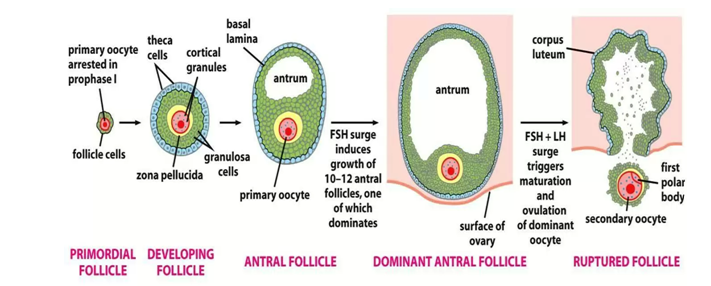
In any case the final production and delivery of the fully competent eggs or sperm require complex hormonal stimulation that occurs in adult, after the reproductive organs are fully mature.
-
If fertilization does not occur, corpus luteum regresses leaving a scarred area called corpus luteum albicans (white body). This leads to subsequent decrease in the level of progesterone.
As this happens, FSH is no longer inhibited and therefore its level increases in the blood. This marks the beginning of ovarian cycle
edu.uptymez.com
2. UTERINE CYCLE
Is a repeating series of changes in the structure of uterus.
It takes 21 – 35 days. It is divided into:-
- Menses
- Proliferation phase.
-
Secretory phase.
-
The Menstrual phase (menses)
This involves the shading of the epithelial lining of the endometrium. This phase and the process associated with it are explained as follows;
Following the regression of the corpus luteum, the level of progesterone in the blood decrease. This leads to the construction of spiral arteries that supply oxygen to the endometrium thus receive
small amount of oxygen and consequently die.
By negative feedback, the spiral arteries then dilates allowing more blood to flow towards the dead cells in the uterine walls.
The pressure exerted by the blood causes the wall to disintegrate and flow out together with variable amount of blood in the menstrual flow. Usually endometrium sloughts out in patches.
-
Proliferation phase (Proliferative phase)
Involves the rapid proliferation multiplication of the endometrium under the influence of oestrogen from developing follicle.
-
Secretory phase
During this phase, progesterone from corpus luteum gland and this maintains the lining of the uterus in receptive state for implantation of the zygote.
Fig:
Uterine cycle
edu.uptymez.com
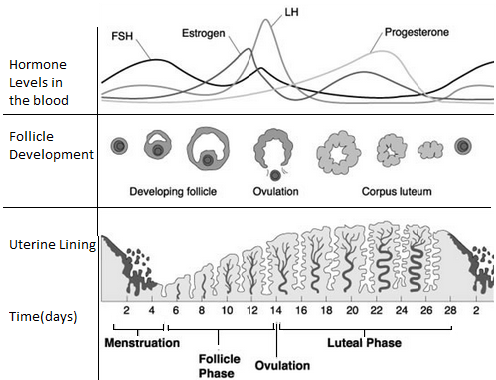
DIFFERENCES
| OESTRUS CYCLE | MENSTRUAL CYCLE | |
| Common to lower mammals eg. Cats, dogs, caw etc. | – Is characteristics to the higher mammals of the order primate eg. Human beings, chimpanzee, gorilla, monkey etc. | |
| In oestrus cycle, the endometrium cycle is absorbed if conception does not occur during the cycle. | -Animals with menstrual cycle shed the endometrium through menstruation. | |
| In species with oestrus cycle, females are generally only sexually active during the oestrus cycle. This is referred to as in heat. | – Females of species with mentrual cycle can be sexually active at any time in their cycle even when they are not about to ovulate. | |
| Period of heightened sexual activity conciding with ovulation is the most prominent event. | – Menstruation, the discharge of blood and uterine lining is the most prominent event. | |
| Occurs less frequently eg. once per year. | – Occurs more frequently than oestrus cycle eg. once every month. |
edu.uptymez.com
NOTE:– Humans unlike some other species have once obvious external signs to signal receptivity at ovulation (concealed ovulation).
- Research has shown however, that women tend to have more sexual thoughts and are most prone to sexual activity right before ovulation.
edu.uptymez.com
SIMILARITIES BETWEEN OESTRUS AND MENSTRUAL CYCLE
- Both comprises of recurring physiological changes that are induced by reproductive hormones in most mammalian placental females.
- Both start after puberty in sexually mature females and are interrupted by oestrus phases, continue until menopause.
edu.uptymez.com
METAMORPHOSIS
Definition:
Metamorphosis is the change of form of an organism in the course of its development.
- Metamorphosis is caused by hormones from the brain and three other endocrine structures two of which are the corpus allatum and corpus cardiacum which are extensions of the brain.
edu.uptymez.com
-
BRAIN
This has neuro – secretory cells for secretion of the brain hormone (BH); This influences the secretion of ecdysone (a hormone controlling ecdysis) hormone from the pro-thoracic glands. The ecdysone
hormone is stored in the thoracic gland.
-
CORPUS ALLATUM
This is an extension of the brain which secretes juvenile hormone (JH). This JH is dominant during the larval stage controls growth and moulting.
-
CORPUS CARDIACUM
It is also extension of the brain which basically receives brain hormone from the neuro-secretory cells of the brain, stores it before pouring it out.
-
PROTHORACIC GLAND
It secretes a prothoracic gland hormone (PGH) or ecdysone hormone. This is secreted when JH diminishes and it controls the process of population and emergency of an adult from the pupa. It is also
controlling ecdysis.
edu.uptymez.com
TYPES OF METARMORPHOSIS
- COMPLETE (holometabolous) METAMORPHOSIS
edu.uptymez.com
Type of metamorphosis in which four stages are involved

Example: – Housefly, butterfly.
Fig: life cycle of a butterfly
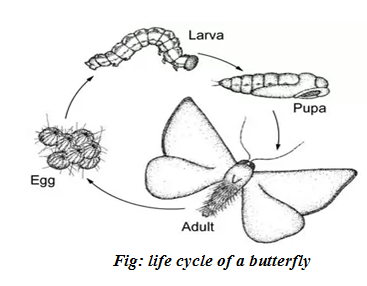
The embryo of an insect (for example a moth butterfly, beetle or fly) which undergo complete metamorphosis develops into a young form called a larva which appears very different from the adult.
Larvae lack many of the structures of the adult.
- Butterfly larva has no wings and lacks compound eyes and jointed legs. They have become little more than feeding machines whose primary function is to find and consume food.
-
Once it has reached a certain size, the lava stops feeding and becomes a pupa by enclosing itself in the protean case within the case tissues are broken down and recognised so that they undergo a
remarkable transformation to the adult form, the imago.
- Once the adult has emerged from the case with fully developed wings, it can no longer moult. This restricts growth.
edu.uptymez.com
- INCOMPLETE (hemimetabolous) METAMOPHORSIS
edu.uptymez.com
Is the type of metamorphosis in which an insect develops through three stages.

Example:- grasshopper, cockroach or locust undergo incomplete metamorphosis.
- The embryo of an insect such as grasshopper, cocroach or locust undergo incomplete metamorphosis.
edu.uptymez.com
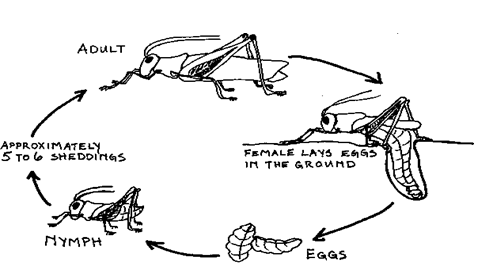
Fig: life cycle of a grasshopper
- It develops into a nymph which closely resembles the adult form but which has a number of adaptive features which enables it to live in different habitat and eat different good from the adult.
- In order to grow the nymph moult several times and go through a number of developmental stages called instars. The instar emerges as the adult with all the adult organs.
edu.uptymez.com
ADVANTAGES OF METAMORPHOSIS
- Metamorphosis enables juvenile and adult forms to live different habitats and exploit different resources. This reduces competition between the different developmental stages.
- Metamorphosis allows the larva and adult stages to become highly specialized for particular functions; usually the larval stage is specially adapted for feeding and the adult for reproduction.
edu.uptymez.com
REPRODUCTION IN FLOWERING PLANTS
– The reproductive structure of the flowering plant is the flower.
GAMETOGENESIS IN FLOWERING PLANTS
– as in animals, gametogenesis in flowering plants is the formation of gametes producing cells, the microspores s and the megaspores. The process whereby the microspores are produced is called Microsporogenesis where as megaspores are produced during megasporogenesis. The former forms pollen embryo female gamete.
DEVELOPMET OF POLLEN GRAINS: MICROSPOROGENESIS:
This occurs in the pollen sacs of the others, in these sacs each pollen or mother cell (2n) undergoes meiosis I to produce two haploid cells. Each of the resulting daughter cells undergoes meiosis II to produce a total of four haploid cells the four cells separate and each cell develops a thick wall over it. This wall is called an exine inside which lies an intine. Te pollen grain at this stage is equivalent to the microspore.
Its nucleus divides by mitosis to produce two nucleus the generation nucleus and the pollen tube nucleus
SEXUAL REPRODUCTION IN PLANT
Sexual reproduction in angiosperms occurs in the gametophyte generation. The structure for sexual reproduction is the flower.
It is within the flower where spore and gametes are developed.
GAMETOGENESIS
Occurs in two ways:-
(i) Microsporogenesis.
(ii)megasporogenesis.
MICROSPOROGENESIS
Is the process by which mature plant produces male gametes (pollen grains or microspores) at anthers of a flower.
The process takes place in the lobes of the anther.
MECHANISM:-
The microspore mother cell pollen mother cell 2n also called primary microsporocyte, undergo meiosis I to produce two haploid cells (dyad).
The products of meiosis I undergo meiosis II producing 4 cells (tetrad). The cells in the tetrad get separated from one another and cell (microspore pollen grain) secretes an additional wall over the present wall.
The nucleus of the pollen grain divides mitotically to produce two nuclei, the pollen tube, nucleus and the generative nucleus.
- At this point the pollen grain and its contents if referred to as the male gametophyte because the male gametes will develop from the generated nucleus.
-
The mature pollen grain has two walls; the inner (INTINE) and the outer (EXINE). Exine has various pits (Sculptures).
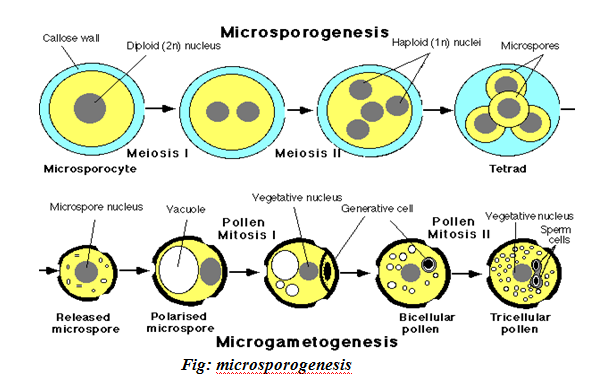
edu.uptymez.com
MEGASPOROGENESIS
This is the development of the embryo sac (megaspore). The process takes place in the ovule of the ovary.
MECHANISM
The megaspore mother cell (2n) undergo meiosis to produce two cells (n) but only one continues to develop under the influence of nutrients from nucleus and become the embryo sac.
- The nucleus of the embryo sac divides mitotically three times to produce 8 nuclei the antipodals migrate, polar nuclei remain at the centre and 3 nuclei the female gamete and sinergid migrate to the microphylen end.
-
Soon after mitosis the embryo sac and its content is referred to as the female gametophyte because one of the nuclei is the female gamete.
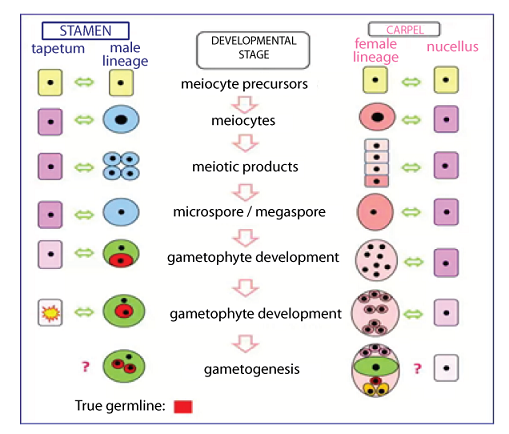
edu.uptymez.com
Fig: Development of embryo sac and female gamete.
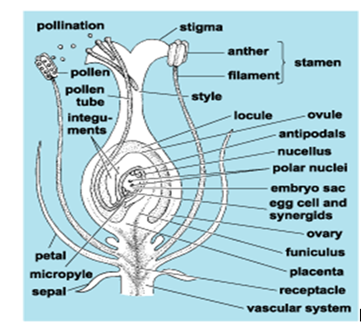
Fig: Is carpel at fertilization. Note that, ovule which becomes the seed after fertilization, contains both diploid parent tissue and haploid embryo sac tissue.
DOUBLE FERTILIZATION AND ITS CONSEQUENCES
Double fertilization is a unique characteristic of the angiosperm. It is a result of multinucleate of the pollen grain and embryo sac.
Definition: Double fertilization is a type of fertilization which occurs in the flowering plant where the two types of nuclear fusion take place.
First: The male gamete nucleus fuses with the female gametes of the embryo sac to form the zygote (2n).
Second: The second male gamete fuses with diploid nucleus (resulting from the fusion of 2 polar nuclei) forming a primary endosperm (3n).
MECHANISM OF DOUBLE FERTILIZATION
The process of double fertilization is proceeded by pollination during which the pollen grain lands on the stigma.
- As the pollen grain lands on the stigma the style tissue stars to secrete sugary solution including sucrose solution. The solutions are absorbed by the pollen grain which consequently swells.
- As a result of swelling; the intine wall grows through the exile via one of the pits as pollen tube under the control of pollen tube down the style.
- As the pollen tube continues to grow, the generative nucleus in the pollen grain divides by mitosis to produce two male gametes. In embryo sac, the two pollen nuclei fuse producing a diploid nucleus and the antipodal as the sinergid degenerate.
- The embryo sac thus remains with only two nuclei an ovum (n) and a diploid nucleus resulting from the fusion of the polar nuclei.
- The pollen tube continues to grow chemotactically towards the embryo sac under influence of chemicals secreted by the embryo sac. As the pollen tube reaches the micropyle, the following occurs in the pollen tube:-
edu.uptymez.com
- The tip of the pollen tube bursts.
- The contents of the pollen grain are discharged into the vicinity of the embryo sac.
edu.uptymez.com
Fertilization occurs following the discharge of contents of pollen grains. It is a double fertilization
How?
- The haploid male gamete fuses with the female gamete to form a diploid zygote nucleus.
-
The second haploid male gamete fuses with the diploid (resulting) from the fusion of two polar nuclei to form a triploid primary endosperm nucleus.
edu.uptymez.com
